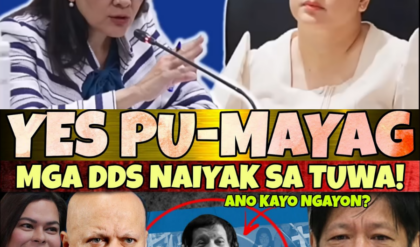After days of rumors, accusations, and political noise, the truth has finally surfaced. The heated exchange between Congressman Leandro Leviste and Department of Public Works and Highways (DPWH) Secretary Vince Dion has dominated social media headlines, leaving Filipinos divided and confused. But now, with Secretary Dion breaking his silence, the picture has become much clearer — and it seems that one congressman may have just been caught in his own storm of speculation.
“Yo, what’s up guys, this is me, I’m back for another vlog!” — that’s how countless Filipino vloggers began their coverage of this latest controversy. But beyond the trending videos and clickbait titles, what’s really going on between Leviste and Dion?
THE START OF THE FIRESTORM

It all began when Congressman Leviste, a first-term lawmaker, accused certain DPWH officials of maintaining suspicious connections with contractors — implying that some ongoing projects might be tainted with corruption. His remarks were bold, fiery, and, for many, reckless.
Leviste specifically mentioned that former DPWH Undersecretary Aray Perez had allegedly resigned just one day after he proposed a background check into department officials. This timing, he claimed, was no coincidence. He further hinted that several members of Secretary Dion’s team were “linked to contractors,” even pointing to a photo showing one official meeting with several businessmen at a restaurant.
To the untrained eye, this seemed like a smoking gun. But to those familiar with how infrastructure projects actually work, the accusation was shaky at best.
SECRETARY DION RESPONDS: “MEETINGS ARE NORMAL — THEY’RE DOING THEIR JOBS.”
When Secretary Vince Dion finally spoke, his response was calm but firm — a statement that effectively dismantled the congressman’s insinuations.
“Yes,” Dion said, “my officials meet with contractors. That’s part of their job.”
According to the Secretary, it’s not only normal but necessary for DPWH officials to hold meetings with contractors — after all, they’re the ones who execute the projects. “How can we bid or supervise infrastructure work without speaking to them?” he asked.
Dion emphasized that the meetings in question were for official business, not for any form of kickback or illegal deal. “There’s nothing shady about it,” he added. “We operate transparently now — the public can see everything.”
And indeed, this aligns with what Dion has been doing since he took office. When he assumed leadership of the DPWH, he cleaned house — removing several high-ranking officials with known corruption records, suspending engineers, accountants, and architects linked to anomalies, and launching an internal review of all district offices.
“Secretary Dion is the first in years to aggressively shake up the DPWH,” one insider told reporters. “He’s serious about reforms — even if it means firing people who’ve been in power for decades.”
THE OLD SYSTEM MEETS THE NEW

The public knows all too well that corruption in the DPWH is not new. For decades, it’s been whispered that officials, contractors, and politicians have colluded to divide government funds, especially those meant for roads, bridges, and flood control projects.
But as many observers have noted, changing an old system takes time — and even more courage. Secretary Dion’s aggressive housecleaning has already earned him both allies and enemies.
That’s why many analysts believe Congressman Leviste’s “revelations” were either premature or politically motivated. “He’s new, maybe he doesn’t yet understand how the system actually works,” said a political commentator. “He probably received partial information from people who want to undermine Dion’s reforms.”
WHAT THE PHOTO REALLY MEANS
The now-viral restaurant photo — supposedly “proof” of DPWH corruption — turned out to be a red herring.
“Yes, that meeting happened,” Dion confirmed, “but it was an official business meeting. There’s a huge difference between a working lunch and an illegal transaction.”
Even the DPWH’s internal audit later confirmed that there was no evidence of wrongdoing. The officials involved were conducting project coordination meetings — standard procedure for infrastructure management.
“Honestly, it’s ridiculous,” one DPWH engineer said off-camera. “Are we supposed to discuss project plans with the walls? Of course, we meet contractors. That’s how work gets done.”
IN DEFENSE OF TRANSPARENCY

In fact, Dion revealed that the DPWH is now adopting blockchain technology — a digital ledger system that allows full transparency of transactions and project funding. This means that once implemented, every peso that enters or exits the DPWH budget can be tracked publicly and permanently.
“Once blockchain is in place,” Dion explained, “no one can manipulate data. The public, journalists, and even Congress will be able to see where funds go — in real time.”
This initiative aims to eliminate the very loopholes that past administrations failed to address. “If corruption happens, blockchain will expose it instantly,” Dion said confidently.
For many Filipinos, this statement hit hard. It wasn’t just a promise — it was a challenge.
LEVISte’s COUNTERPOINTS — AND THE REBUTTAL
In response, Congressman Leviste maintained that he was only doing his duty. He called on Secretary Dion to do three things:
Disclose all DPWH officials’ connections with contractors;
Ensure price reductions in public works projects by at least 25%;
Release the DPWH budget per legislative district for public scrutiny.
While these points sound reasonable on paper, critics were quick to note that Dion is already implementing many of these reforms. Transparency, cost reduction, and accountability are precisely why blockchain is being introduced.
“Congressman Leviste’s proposals are valid,” said one analyst, “but they’re not new. The DPWH is already working on these. He should have verified before making sensational claims.”
THE REAL MESSAGE BEHIND THE CONTROVERSY
Beyond the noise of politics, this issue highlights a larger story — the ongoing struggle to clean up the DPWH, one of the most corruption-plagued agencies in the country.
Secretary Dion’s strategy is not to deny that corruption exists, but to systematically dismantle it. By enforcing transparency and digital auditing, he hopes to end decades of backdoor deals that have bled taxpayers dry.
As for Congressman Leviste, the controversy may serve as a reminder that in politics, accuracy matters more than attention. His passion for reform is admirable, but his methods — releasing unverified information — risk undermining the very cause he claims to support.
THE FINAL WORD
For now, Secretary Dion remains focused on his mission. “We’re not perfect,” he admitted, “but we’re getting there. If anyone in my team is caught taking money or colluding with contractors, they’ll be removed and prosecuted — no exceptions.”
It’s a strong statement — and one that many hope will finally mark a turning point in the DPWH’s long, scandal-stained history.
Meanwhile, Congressman Leviste has yet to respond to Dion’s clarifications. Whether he will apologize, double down, or quietly move on remains to be seen.
But one thing is clear: in this battle of words, truth has its own way of surfacing.
As one vlogger summed it up in his latest upload:
“Well, that’s it, mga sangkay — the truth’s out. No corruption, just a meeting. Maybe next time, let’s check the facts first before dropping another ‘pasabog.’”
Stay safe, stay smart, and keep your eyes open — because in Philippine politics, there’s always another story waiting to explode.




